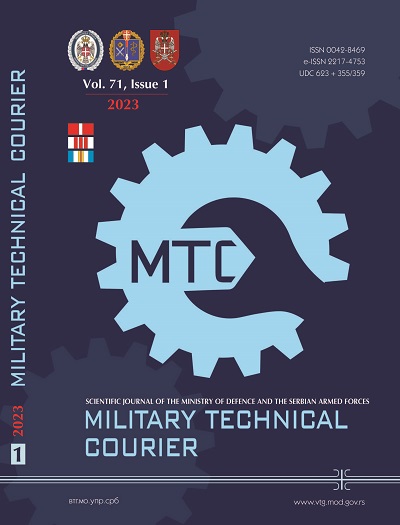Military green technology: present and future
Abstract
Introduction/purpose: This paper aims to present military green technology through present concepts, solutions and challenges, as well as through future trends, particularly in wireless communication.
Methods: Analyses and syntheses were used to consider various aspects, challenges and developments of military green technology.
Results: Important aspects of organization, challenges and strategies in military green technologies are presented. Next, the role of a green energy action plan is emphasized. Furthermore, green defence solutions and security challenges are considered. Besides presenting green technologies of today, primarily focused on wireless networks, especially 5G, the paper also considers the impact of biofuels, methanol-based fuel cells, hydrogen fuel cells, hybrid electrical vehicles and photovoltaic energy. Finally, green technologies for the future are presented through some of the most important technologies: next generation wireless networks, pulse detonation engines, piezoelectricity, and biodegradable platforms.
Conclusion: Military green technology is now necessary for approaching wireless networking in order to meet challenges of high demands of wireless traffic and energy consumption. Also, military green technology will require further constant considerations in the field of efficiency and sustainability of application as well as research to provide different acceptable solutions, not only in technical, but also in the organizational domain, in order to be applied in military environment.
References
Bojkovic, Z.S., Milovanovic, D.A. & Fowdur, T.P. 2020. 5G Multimedia Communication: Technology, Multiservices, and Deployment, Chapter I, pp.3-29. Boca Raton: CRC Press. Available at: https://doi.org/10.1201/9781003096450>
Burg, D. & Scharre, P. 2015. The 100 Billion Question: The Cut Case for Naval Uninhibited Combat Aircraft. Center for a New American Security [online]. Available at: https://www.jstor.org/stable/resrep06136 [Accessed: 27 November 2017].
Crull, W.A. 2006. Direct Methanol Fuel Cells [online]. Available at: https://www.altenergymag.com/article/2006/10/direct-methanol-fuel-cells/37/ [Accessed: 15 January 2022].
-Danish Ministry of Defence. 2021. Summary of the Green Action Plan 2021-2025 [online]. Available at: https://www.fmn.dk/globalassets/fmn/dokumenter/strategi/miljo/-summary-of-the-green-action-plan-.pdf [Accessed: 15 January 2022].
-DARPA (Defence Advanced Research Projects Agency). 2015. Vanishing Acts: A Cell for disappearing Delivery Vehicles [online]. Available at: https://www.darpa.mil/news-events/2015-10-09 [Accessed: 9 December 2017].
-DARPA (Defence Advanced Research Projects Agency). 2017. Episode 11: The Thin-Air Specialist [online]. Available at: https://www.youtube.com/watch?v=MzZyWJjkEKk [Accessed: 9 Decembar 2017].
Dillow, C. 2009. Smart Armor Knows its Own Strength, As Well As the Enemy’s. Popular Science [online]. Available at: https://www.popsci.com/technology/article/2009-11/smart-armor-knows-low-its-own strength-and-enemy [Accessed: 25 December 2021].
Johnson, J.J. 2010. An integrated command and control architecture concept for unmanned systems in the year 2030. Ph.D. thesis. Monterey, California: Naval Postgraduate School [online]. Available at: https://core.ac.uk/download/pdf/36698951.pdf> [Accessed: 20 November 2021].
Lamprecht, D. 2007. Fischer−Tropsch Fuel for Use by the U.S. Military as Battlefield-Use Fuel of the Future. Energy and fuels, 21(3), pp.1448-1453. Available at: https://doi.org/10.1021/ef060607m>
Miao, G., Himayat, N. & Li, G.Y. 2010. Energy efficient limit adaptation in frequency-selective channels. IEEE Transactions on Communications, 58(2), pp.545-554. Available at: https://doi.org/10.1109/TCOMM.2010.02.080587>
Shannon, C.E. 1948. A mathematical theory of communications. Bell System Technical Journal, 27(4) pp.623-656. Available at: https://doi.org/10.1002/j.1538-7305.1948.tb00917.x>
Copyright (c) 2023 Zoran Miličević, Zoran Bojković

This work is licensed under a Creative Commons Attribution 4.0 International License.
Proposed Creative Commons Copyright Notices
Proposed Policy for Military Technical Courier (Journals That Offer Open Access)
Authors who publish with this journal agree to the following terms:
Authors retain copyright and grant the journal right of first publication with the work simultaneously licensed under a Creative Commons Attribution License that allows others to share the work with an acknowledgement of the work's authorship and initial publication in this journal.
- Authors are able to enter into separate, additional contractual arrangements for the non-exclusive distribution of the journal's published version of the work (e.g., post it to an institutional repository or publish it in a book), with an acknowledgement of its initial publication in this journal.
- Authors are permitted and encouraged to post their work online (e.g., in institutional repositories or on their website) prior to and during the submission process, as it can lead to productive exchanges, as well as earlier and greater citation of published work (See The Effect of Open Access).

